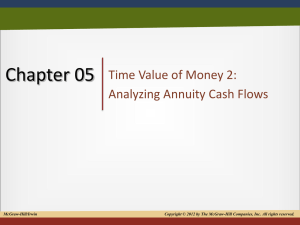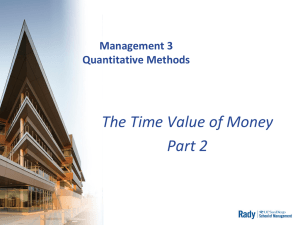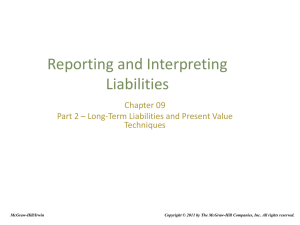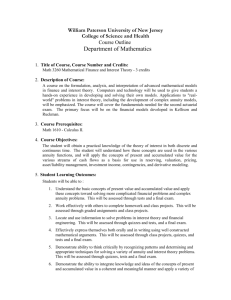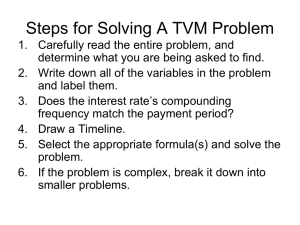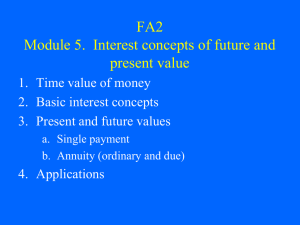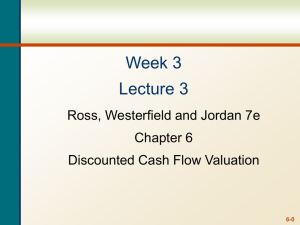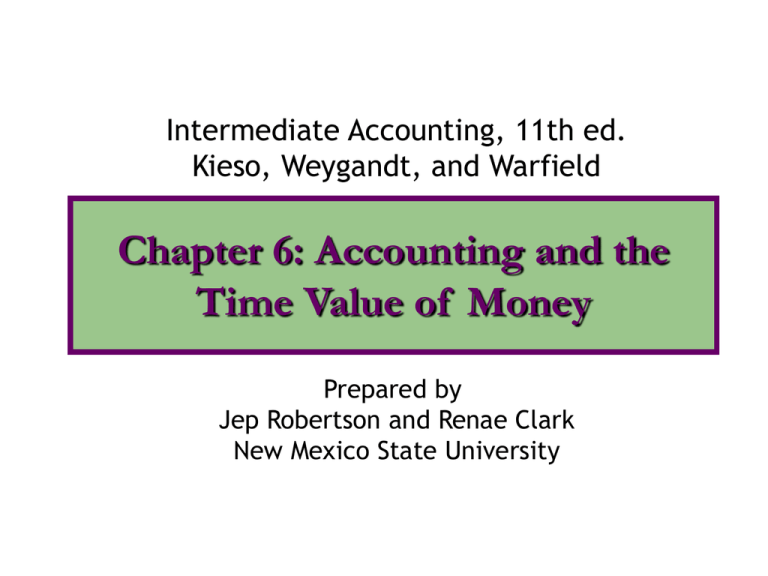
Intermediate Accounting, 11th ed.
Kieso, Weygandt, and Warfield
Chapter 6: Accounting and the
Time Value of Money
Prepared by
Jep Robertson and Renae Clark
New Mexico State University
Chapter 6: Accounting and the
Time Value of Money
After studying this chapter, you should be
able to:
1. Identify accounting topics where time value
of money is relevant.
2. Distinguish between simple and compound
interest.
3. Learn how to use appropriate compound
interest tables.
4. Identify variables fundamental to solving
interest problems.
Chapter 6: Accounting and the
Time Value of Money
5. Solve future and present value of 1
problems.
6. Solve future value of ordinary and annuity
due problems.
7. Solve present value of ordinary and annuity
due problems.
8. Solve present value problems related to
deferred annuities and bonds.
9. Apply expected cash flow approach to
present value measurement.
Basic Time Value Concepts
• The time value of money is the
relationship between time and money.
• According to the present value of
money concept, a dollar earned today
is worth more than a dollar earned in
the future.
• This concept is used to choose among
alternative investment proposals.
Accounting Applications
•
•
•
•
•
•
•
•
Notes
Leases
Pensions
Long-term assets
Sinking funds
Business combinations
Disclosures
Installment contracts
Variables in Interest Computations
• Principal: The amount borrowed or
invested
• Interest rate: A percentage of the
outstanding principle.
• Time: the number of years or
fractional portion of a year that
principal is outstanding.
Basic Time Diagram
Choosing an Interest Rate in Time
Value Measurements
The appropriate interest rate
depends on:
• the pure rate of interest
• credit risk rate of interest
• expected inflation rate of interest
The higher the credit risk, the
higher the interest rate.
Choosing an Interest Rate in Time
Value Measurements
Simple and Compound Interests
• Simple interest is determined on the
principal only.
principal x interest rate (%) x time
• Compound interest is determined on:
the principal, and any interest earned (and
not withdrawn).
• Compound interest is the typical
computation applied in most time value
applications.
Compound Interest Tables
• Future value of $1
• Present value of $1
• Future value of an ordinary annuity
of $1
• Present value of an ordinary annuity
of $1
• Present value of an annuity due of $1
Interest Rates and Frequency
Compounding
Assumed interest rate per year: 12%
Frequency of
Compounding
Interest rate per
compounding
Number of compounding
periods
Annual
12%
One (1)
Semi-annual
6%
Two (2)
Quarterly
3%
Four (4)
Monthly
1%
Twelve (12)
Single Sum Problems
Typically one of two types:
• Computing a future value of a known
single sum present value.
• Computing a present value of a
known single sum future value.
Single Sum Problems: Future
Value of Single Sum
Given:
•
Amount of deposit today (PV):
$50,000
•
Interest rate
11%
•
Frequency of compounding: Annual
•
Number of periods (5 years): 5 periods
What is the future value of this single sum?
(use Table 6-1 to determine the factor of
1.68506)
$50,000 x (1.68506) = $84,253
Single Sum Problems: Present
Value of Single Sum
Given:
• Amount of deposit end of 5 years: $84,253
•
Interest rate (discount) rate:
11%
•
Frequency of compounding:
Annual
•
Number of periods (5 years):
5 periods
What is the present value of this single sum?
(use Table 6-2 to determine the factor of
.59345)
$84,253 x (0.59345) = $50,000
Annuity Computations
An annuity requires that:
• the periodic payments or receipts
(rents) always be of the same
amount,
• the interval between such payments
or receipts be the same, and
• the interest be compounded once
each interval.
Types of Annuities
Annuities may be broadly classified as:
• Ordinary annuities: where the rents
occur at the end of the period.
• Annuities due: where rents occur at
the beginning of the period.
Annuities: Future Value of an
Ordinary Annuity
Given:
• Deposit made at the end
$5,000
• Compounding:
• Number of periods:
• Interest rate:
of each period:
Annual
Five
12%
What is future value of these deposits?
Use table 6-3 to derive the factor of 6.35285
$5,000 x (6.35285) = $ 31,764.25
Annuities: Present Value of an
Ordinary Annuity
Given:
• Rental receipts at the end of each period:
$6,000
• Compounding:
Annual
• Number of periods (years):
5
• Interest rate:
12%
What is the present value of these receipts?
Use table 6-4 to derive the factor of 3.60478
$6,000 x (3.60478) = $ 21,628.68
Annuities: Future Value of an
Annuity Due
Given:
Deposit made at the beginning of each
period:
•
•
•
Compounding:
Number of periods:
Interest rate
$ 800
Annual
Eight
12%
What is the future value of these deposits?
Annuities: Future Value of an
Annuity Due
First Step:
Convert future value of ordinary annuity factor to
future value for an annuity due:
• Ordinary annuity factor: 8 periods, 12%: 12.29969
• Convert to annuity due factor: 12.29969 x 1.12:
13.77565
Second Step:
Multiply derived factor from first step by the
amount of the rent:
• Future value of annuity due:
$800 x 13.77565 =
$11,020.52
Annuities: Present Value of an
Annuity Due
Given:
• Payment made at the beginning of each
period:
$ 4.8
• Compounding:
Annual
• Number of periods:
Four
• Interest rate
11%
What is the present value of these payments?
Annuities: Future Value of an
Annuity Due
First Step:
Convert future value of ordinary annuity factor to
future value for an annuity due:
• Ordinary annuity factor: 4 periods, 11%: 3.10245
• Convert to annuity due factor: 3.10245 x 1.11
3.44372
Second Step:
Multiply derived factor from first step by the
amount of the rent:
• Present value of annuity due: $4.8M x 3.44372:
$16,529,856
Complex Situations
Deferred Annuities:
• Rents begin after a specified number
of periods.
Valuation of Long-term Bonds:
• Two cash flows: principal paid at
maturity and periodic interest
payments
Expected Cash Flow Approach
• Introduced by SFAC No. 7
• Uses a range of cash flows.
• Incorporates the probabilities of those
cash flows to arrive at a more
relevant measurement of present
value.
COPYRIGHT
Copyright © 2004 John Wiley & Sons, Inc. All rights reserved.
Reproduction or translation of this work beyond that permitted
in Section 117 of the 1976 United States Copyright Act without
the express written permission of the copyright owner is
unlawful. Request for further information should be addressed
to the Permissions Department, John Wiley & Sons, Inc. The
purchaser may make back-up copies for his/her own use only
and not for distribution or resale. The Publisher assumes no
responsibility for errors, omissions, or damages, caused by the
use of these programs or from the use of the information
contained herein.


